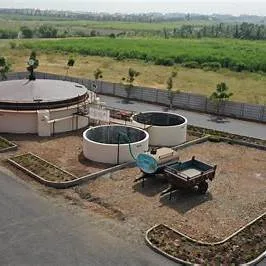🔋 Anaerobic Biogas Digester Technology: Reliability, Process, Risks & Management
🌱 1. Introduction
Anaerobic Biogas Digester is a clean energy technology that transforms organic and agricultural waste into biogas, mainly methane (CH₄), through a microbial fermentation process in oxygen-free conditions.
✔️ Reduces greenhouse gas emissions
✔️ Produces renewable energy
✔️ Generates valuable organic fertilizer (digestate)
This eco-friendly solution is gaining popularity in farming, agro-industrial, and municipal sectors for its dual benefits: waste reduction + energy production.
🔧 2. Technology Reliability
💡 Biogas digesters are highly reliable and efficient. Here’s why:
-
🔁 Continuous Operation – Functions 24/7 with consistent feedstock.
-
🛠️ Long Lifespan – Lasts 10–20 years with proper care.
-
⚡ Energy Efficiency – Converts 60–70% of organic content into usable energy.
-
♻️ Versatile Input – Accepts manure, crop residues, food waste, and more.
-
🧩 Modular Designs – Scalable systems from multiple global vendors.
🔄 3. Biogas Production Process Flow
The anaerobic digestion process consists of five key stages:
🏗️ Stage 1: Feedstock Collection
-
🌾 Crop waste: rice husk, sugarcane bagasse
-
🐄 Animal manure: cow, poultry, pig
-
🥬 Organic leftovers: food scraps, dairy sludge
⚙️ Stage 2: Pretreatment
-
🌀 Chopping & mixing with water
-
🎯 Improves microbial access & gas yield
🔬 Stage 3: Anaerobic Digestion (Multi-phase Reaction)
-
Hydrolysis: Breaks down complex molecules
-
Acidogenesis: Converts sugars to acids
-
Acetogenesis: Produces acetic acid, H₂, CO₂
-
Methanogenesis: Generates CH₄ and CO₂
💨 Stage 4: Biogas Purification
-
Removes:
-
☠️ Hydrogen Sulfide (H₂S)
-
💧 Moisture
-
-
Result: Cleaner, more efficient gas
🔋 Stage 5: Utilization & Storage
-
⚡ Electricity & heating
-
🚗 Transportation fuel
-
🌿 Digestate as organic fertilizer
⚠️ 4. Risks, Challenges & Mitigation
Even the best tech comes with challenges. Let’s break them down:
🛑 A. Technical Risks
-
🌡️ Temperature sensitivity – Needs 35–38°C or 50–55°C (with heating)
-
🧪 C/N imbalance – Ideal Carbon/Nitrogen ratio = 20–30
-
☣️ Toxic inhibitors – Avoid NH₃, H₂S, and heavy metals
-
🪤 Sludge build-up – Requires agitation or flushing
💸 B. Financial Risks
-
🏗️ High CAPEX – Solutions: green financing, ESG investors
-
📉 Market fluctuations – Secure PPAs with buyers
-
💰 Subsidy dependence – Diversify with digestate sales
🌍 C. Environmental & Social Risks
-
👃 Odor issues – Install biofilters & sealed tanks
-
🏘️ Community resistance – Conduct social engagement & training
🧑🔧 5. Digester Management Strategies
🔍 A. Operational Management
Key parameters to monitor:
-
🧪 pH: 6.8–7.5
-
🌡️ Temperature: 35–38°C
-
🔥 CH₄ content: >50%
-
⏱️ HRT (Hydraulic Retention Time): 15–30 days
✅ Regular Tasks:
-
Gas leak inspection
-
Mixing sludge
-
Microbial health check
💰 B. Financial Management
Revenue Streams:
-
🔌 Sale of biogas
-
🌱 Organic fertilizer from digestate
-
🌍 Carbon credits
-
💵 Feed-in Tariffs (FiT)
Financial Outlook:
-
💼 CAPEX: $500,000 – $5,000,000
-
⏳ ROI: 3–7 years
-
📊 OPEX: feedstock, labor, maintenance
🏭 6. Leading Digester Technology Providers
Check out these reputable global vendors:
-
🇳🇱 Paques Environmental Technology (Netherlands)
-
🇨🇦 Xebec Adsorption Inc. (Canada)
-
🇩🇪 Envitec Biogas AG (Germany)
-
🇩🇪 Weltec Biopower (Germany)
-
🇺🇸 CH4 Biogas (USA)
-
🇮🇩 PT Gikoko Kogyo Indonesia (Indonesia)
📚 7. Key References
🔬 Scientific & Technical
-
Angelidaki, I., et al. (2003). Biomass and Bioenergy
-
Gerardi, M. H. (2003). The Microbiology of Anaerobic Digesters
-
Weiland, P. (2010). Applied Microbiology & Biotechnology
🛠️ Industry Bodies
-
German Biogas Association (Fachverband Biogas e.V.)
-
American Biogas Council (ABC)
📈 Financial Reports
-
World Bank (2022) – Biogas Market Assessment
-
IEA (2024) – Biogas Outlook
✅ 8. Conclusion
Anaerobic Biogas Digester is a powerful solution for sustainable energy and organic waste management. It transforms problems (waste) into opportunities (energy and fertilizer).
With the right technical approach, stakeholder engagement, and risk mitigation, this technology can:
-
🌿 Protect the environment
-
💡 Produce reliable energy
-
💵 Deliver long-term profit
💭 Investing in biogas today is a step toward a cleaner, circular, and more resilient tomorrow.






